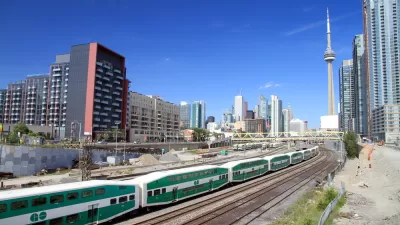San Diego County's "most walkable city" is being challenged to identify the real smart growth: what it has or what is being proposed. At issue: a plan amendment for a high density project near transit. But is the project real?
Identifying a project as "smart growth" can be a powerful argument for relief from local zoning restrictions and plans, notes land use attorney Bill Adams. While density, proximity to transit, and other physical attributes help determine whether a project is "smart," should communities consider a much more preliminary, non bricks and mortar, question? Adams looks at a proposal in his own neighborhood:
"The “Village” area of the City of La Mesa remains a sleepy hamlet nestled among foothills despite having been enveloped on all sides by suburban sprawl and freeways. With its traditional main street and railway stop, it’s a rarity in Southern California. It has been recognized as the most walkable city in San Diego County. However, the way the Village views itself is being fundamentally challenged.
"Recently, the main topic of conversation in La Mesa has been a large mixed use development proposal . . . If built as proposed, it will include the city’s tallest building at 9-11 stories (110 feet). Current buildings adjacent to the site are 1 – 2 story detached residences and retail buildings. . . existing zoning allows retail and multifamily housing up to a height of 46 feet, i.e., 4 – 5 stories – a significant bump in density." Adams writes that the project proponents tout its 'smartness' due to its proximity to a light rail line and its density. However, he goes on to observe,
"Questions concerning spot zoning, sprawl, and impacts on the surrounding neighborhood are garnering the most, if not all, the attention concerning the Park Station proposal. However another question is circulating . . . Is this a real project? Or is it a trojan horse?"
Adams looks at a number of factors, especially those pertaining to financing the project, to determine whether the project has a realistic chance of being built as proposed. He also discusses the consequences of approving variances and plan amendments for unrealistic proposals. He concludes that determining the reality of a project being built as proposed may be as important to "smart growth" as the physical form of the project, especially when a community is being asked to grant variances or amend its plans or codes.
FULL STORY: When is a “Smart Growth” Project a “Trojan Horse”? – Park Station as a case study.

Planetizen Federal Action Tracker
A weekly monitor of how Trump’s orders and actions are impacting planners and planning in America.

Maui's Vacation Rental Debate Turns Ugly
Verbal attacks, misinformation campaigns and fistfights plague a high-stakes debate to convert thousands of vacation rentals into long-term housing.

Restaurant Patios Were a Pandemic Win — Why Were They so Hard to Keep?
Social distancing requirements and changes in travel patterns prompted cities to pilot new uses for street and sidewalk space. Then it got complicated.

In California Battle of Housing vs. Environment, Housing Just Won
A new state law significantly limits the power of CEQA, an environmental review law that served as a powerful tool for blocking new development.

Boulder Eliminates Parking Minimums Citywide
Officials estimate the cost of building a single underground parking space at up to $100,000.

Orange County, Florida Adopts Largest US “Sprawl Repair” Code
The ‘Orange Code’ seeks to rectify decades of sprawl-inducing, car-oriented development.
Urban Design for Planners 1: Software Tools
This six-course series explores essential urban design concepts using open source software and equips planners with the tools they need to participate fully in the urban design process.
Planning for Universal Design
Learn the tools for implementing Universal Design in planning regulations.
Heyer Gruel & Associates PA
JM Goldson LLC
Custer County Colorado
City of Camden Redevelopment Agency
City of Astoria
Transportation Research & Education Center (TREC) at Portland State University
Jefferson Parish Government
Camden Redevelopment Agency
City of Claremont



























